Masks of Esther
All of us, sometime or other, hide behind a mask. Whether it is a strange new identity we momentarily assume for Purim or simply filling the public role of father, mother or child, teacher or even artist. The mask, which represents the ideal role we are expected to play, might be the first thing anyone sees until the reality of our personality manages to appear. Masks are something we all wear, but here in America, we also almost always take them off. Here we feel that we have less to fear from the outside world and can let our guard down. This isn’t always true. For example, Persia in the time of Mordechai and Esther was not a good time for the Jews.
Ahasuerus had donned stolen priestly garments and plundered the holy Temple vessels to use at a drunken wine banquet. While the Jews were powerless to stop him, sadly they even participated in the festivities in Shushan. These were clearly very bad times. They were times in which masks were necessary.
Shoshana Golin, printmaker and painter, presents us with a deeper understanding the Book of Esther in her masterful etchings, the Book of Esther Series, now being shown at the Manhattan Graphics Center, through December 2, 2001. This series consists of but five prints among the twenty-one works she is currently exhibiting. She works in a variety of graphic mediums including etchings with aquatint or drypoint, and monotypes. We see here six luminous landscapes in color from Alon Shevut that forcefully capture the rugged Judean landscape around the yeshiva there. Also, the two intriguing renditions of Rachel and Jacob that explore the verse; “Give me children, or else I die…. [and Jacob’s response] Am I in the place of God, who has withheld from the fruit of the womb.” (Gen. 30:1-2) show her skill at using traditional commentaries such as the Akaidat Yitzchak to enlarge and explain Jacob’s puzzling response to the wife he loved so dearly. Notwithstanding the considerable technical skill and interpretive power of these works, her Book of Esther Series towers above them by its sheer creative audacity totally re-understanding a central theme found in Esther.
The five etchings (with drypoint) are shown as three small rectangles interspersed with two larger verticals. A textual explanation that utilizes quotations from the Midrash and Golin’s own commentary accompanies the etchings. The meanings for the viewer of this series emerge from a three-way dialogue between the text of the Book of Esther we all know, Golin’s explanation and the forceful images of the etchings themselves.
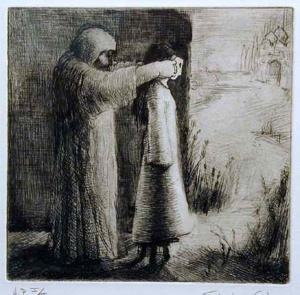
The first etching is Hadassah/Esther. She is shown as an adolescent girl, perched on a three legged stool. A hooded Mordechai is behind her putting a small mask over her face as she stands passively (notice that her hands disappear in the shadows of her gown) facing the doorway. The use of the visual metaphor of a mask to express the central motif of Esther’s hidden identity is a brilliant stroke that becomes the thematic core of the series. Golin poignantly evokes the interior emotions of the pure and innocent young woman as the print reflects her commentary, “…Mordechai will push her into the outside and unknown world of the palace.”
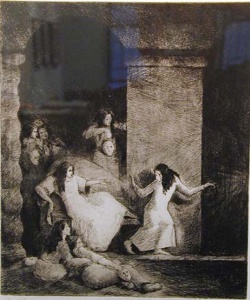
The next image is of Esther in the harem. She must still hide her true identity and so the counting technique related in the Talmud of seven maids serving her in the harem with one specially assigned for Shabbos allows her be simultaneously observant and yet concealed. We see in the etching a further method of concealment in which not only is Esther masked, but her maidens too carry masks that will further obfuscate the fact that a pious Jew is resident in the King’s harem.
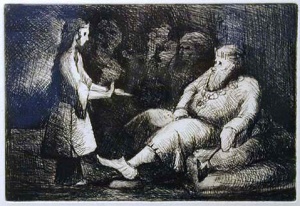
The Invitation is perhaps the most disarming of all the etchings. “Mordechai orders Esther to go to King Ahasuarus… Esther balks. She has never gone to the King willingly… She knew that she had never violated Jewish law by her contact with the King because it had never been as a willing participant. This will now change. She will now cross the border.” To save the Jewish people, Esther must not only risk her life, but her Jewish morality as well. Golin transforms this terrifying event into a fairly tale image that defuses the intense reality just enough for us to finally understand what is at stake for Esther the young woman. Esther, masked, stands before the slovenly and buffoonish King. He is still dangerous, even his outlandish foot stretched toward Esther is ominous. And yet Esther’s courage is expressed in her curious hand gestures. One hand is extended palm up, indicating invitation (to a wine feast) and the other hand is raised in a gesture of “Stop” indicating her defiant and reserved honor.
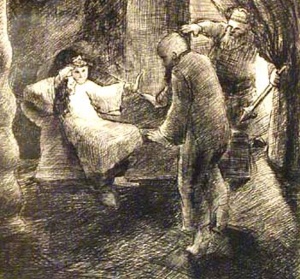
Esther’s Party uses irony to explore the complexity of the most dramatic moment of the narrative, the revelation of her identity to the King and the murderous intent of Haman. But here the artist puts yet another spin on the story. Again through the use of the mask, she reveals Esther to the King but conceals her from us the audience. Could it be that this young orthodox woman is telling us that understanding Jewish women, from Esther down to the present, is perhaps not such a simple task as we might have thought?
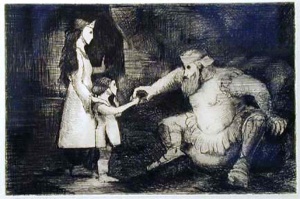
And finally the last etching takes us firmly into the present. Esther’s Child: Epilogue depicts Esther, still masked, presenting her young son, Darius, to the old King, his father. We immediately ask ourselves, why the need for the masks now that the Jews have been saved and disaster avoided. And we can only conclude that even when out of danger, in a friendly and peaceful royal court, the dangers of life in a non-Jewish environment, moral and even physical, are never far from the surface. Therefore the masks we wear, those that identify us in our everyday roles and as Jews, are still necessary to conceal as well as reveal truths hidden in plain sight.
Hester Panim, the hidden nature of God in the Book of Esther, is the major theme that Shoshana Golin harnesses by means of the Masks of Esther to explore and re-understand the meaning of Jewish identity in an alien world as well as the pivotal role of today’s Jewish women. By means of these subtle masks on little Esther the artist has revealed another reason why the Megillah will be relevant for us through the end of time.
Shoshana Golin
Prints Manhattan Graphics Center
481 Washington Street, New York, NY 10013